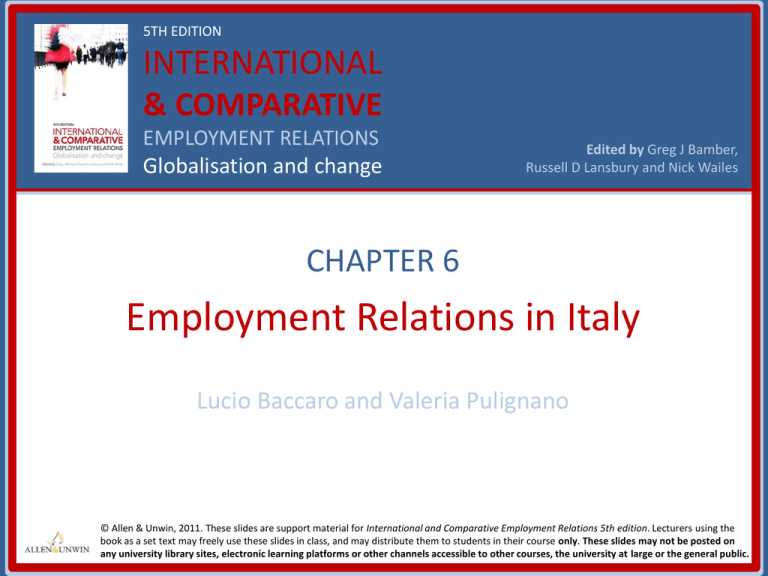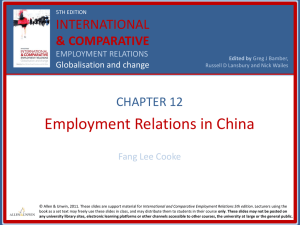Italy PP Slides - Sage Publications
advertisement

5TH EDITION INTERNATIONAL & COMPARATIVE EMPLOYMENT RELATIONS Globalisation and change Edited by Greg J Bamber, Russell D Lansbury and Nick Wailes CHAPTER 6 Employment Relations in Italy Lucio Baccaro and Valeria Pulignano © Allen & Unwin, 2011. These slides are support material for International and Comparative Employment Relations 5th edition. Lecturers using the book as a set text may freely use these slides in class, and may distribute them to students in their course only. These slides may not be posted on any university library sites, electronic learning platforms or other channels accessible to other courses, the university at large or the general public. International & Comparative Employment Relations 5th edition Edited by Greg J Bamber, Russell D Lansbury & Nick Wailes Lecture outline • • • • • • • • • • • • Key themes Italian employment relations after WWII Industrial events 1960s-1980s Italian employer associations Italian unionism Workplace representative structures Shift to a corporatist system The corporatist system today Employment relations at the industry level Employment relations at the company level Labour relations in the public sector Conclusions – current and future issues Chapter 6: 2 Italy Copyright Allen & Unwin, 2011 International & Comparative Employment Relations 5th edition Edited by Greg J Bamber, Russell D Lansbury & Nick Wailes Key themes • The Italian industrial relations system does not fit easily into cross-country classificatory schemes in either the corporatist or VoC literature • Historically, Italian unions have been militant and politicised – they were generally unwilling to compromise on a much-needed policy of centralised wage moderation • The Italian industrial system changed dramatically during the 1990s due to a series of social pacts and collaboration between governments, unions and some organised employers • There has been a shift towards a new kind of corporatism in the context of declining unionism • There are serious questions about whether Italian unionism will continue to be an important industrial actor, particularly in the private sector Chapter 6: 3 Italy Copyright Allen & Unwin, 2011 International & Comparative Employment Relations 5th edition Edited by Greg J Bamber, Russell D Lansbury & Nick Wailes Italian employment relations post WWII • The trajectory of Italian employment relations after WWII was strictly linked to the evolution of the Italian political system • By the 1950s, Italian trade unions were particularly weak and collective bargaining was almost completely centralised at the national level, which benefited employer interests • Wage moderation and labour quiescence contributed to create the preconditions for the economic success of the late 1950s and early 1960s • Italian industrial relations changed dramatically in the 1960s as industrial conditions became much more favourable to labour • Changes in the political arena with the emergence of centre-left governments also eased ideological tensions that had previously divided the labour movement Chapter 6: 4 Italy Copyright Allen & Unwin, 2011 International & Comparative Employment Relations 5th edition Edited by Greg J Bamber, Russell D Lansbury & Nick Wailes Industrial events 1960s-1980s • ‘Hot Autumn’ – a massive wave of strikes in the late 1960s and early 1970s – led to the partial reunification of the labour movement and innovations in collective bargaining • This period overturned virtually all of the social, economic and political patterns established in the post-war period • However, the greatly increased labour costs were disastrous for Italian export-led development, undermining the viability of the Italian economy • The response was the ‘EUR Policy’ in the late 1970s – unions agreed to moderate wage demands and limit industrial conflict in return for participation in national policy-making • The EUR Policy had limited success until the 1980s, when it disintegrated, resulting in the splitting of the labour movement and the decentralisation of collective bargaining Chapter 6: 5 Italy Copyright Allen & Unwin, 2011 International & Comparative Employment Relations 5th edition Edited by Greg J Bamber, Russell D Lansbury & Nick Wailes Italian employer associations • The most important employer association is Confindustria – density rate of approximately 29% • Competing interests within Confindustria – Large enterprises face militant unions and favour some form of union dialogue – Small-medium enterprises face weak unions and favour a strong antiunion approach • There have been recent policy shifts to interests of small-medium enterprises • Other smaller, industry- and service-specific employer organisations exist. These are often aligned with political parties but generally follow the line of Confindustria Chapter 6: 6 Italy Copyright Allen & Unwin, 2011 International & Comparative Employment Relations 5th edition Edited by Greg J Bamber, Russell D Lansbury & Nick Wailes Italian unionism • Aggregate union density rates peaked at 50% in the late 1970s and have steadily declined to an estimate of 29% in 2006 • There are three major union confederations: – Confederazione Generale Italiana del Lavoro (CGIL) – Confederazione Italiana Sindacati dei Lavoratori (CISL) – Unione Italiana dei Lavoratori (UIL) • The CGIL, CISL and UIL organise an estimated 81% of all union members • Union density is 44% in the public sector and 19% in the private sector • Union density is much higher amongst older workers (including retired members), with unions struggling to organise younger workers Chapter 6: 7 Italy Copyright Allen & Unwin, 2011 International & Comparative Employment Relations 5th edition Edited by Greg J Bamber, Russell D Lansbury & Nick Wailes Organisational structures • Both the key employer and union confederations have the same structure: – Vertical, industry-based organisational structures, linking enterprise level, provincial industry organisation and national industry federations – Horizontal (territorial) structures • There has been a tendency towards consolidation of the union industry federations through mergers • Union structures have remained relatively stable above the workplace level but have changed considerably within the workplace itself Chapter 6: 8 Italy Copyright Allen & Unwin, 2011 International & Comparative Employment Relations 5th edition Edited by Greg J Bamber, Russell D Lansbury & Nick Wailes Workplace representative structures • In the pre-fascist period and again after 1943, workplace representation occurred through Commissione Interna (internal commissions) which were like small parliaments ensuring smooth relations between workers and companies • During the Hot Autumn, Consigli di Fabbrica (factory councils) were established. Simultaneously the Worker’s Statute (Law 300) of 1970 authorised unions to set up workplace representation structures called Rappresentanze Sindacali Aziendali (RSA). The existing factory councils were recognised by the union confederations as such RSA bodies • When relations between the 3 main union confederations deteriorated in the 1980s, their joint factory councils were disbanded or reformed Chapter 6: 9 Italy Copyright Allen & Unwin, 2011 International & Comparative Employment Relations 5th edition Edited by Greg J Bamber, Russell D Lansbury & Nick Wailes Rappresentanze Sindacale Unitarie (RSU) • In 1993, representative worker councils in the form of the RSU were introduced into workplaces, again ensuring union control over work councils at the enterprise level • RSUs became the formal bargaining agents with consultation and information rights • Through the RSU, unions were able to make use of a more reliable base to negotiate change and regulate employment relationships on the shop floor • The introduction of the RSU spurred a wave of union elections and reaffirmed the confederal unions’ claim to general representation • The RSUs gave the unions renewed legitimacy and momentum, but this did not prevent a serious erosion of union density, particularly in the public sector Chapter 6: 10 Italy Copyright Allen & Unwin, 2011 International & Comparative Employment Relations 5th edition Edited by Greg J Bamber, Russell D Lansbury & Nick Wailes Shift to a corporatist system • 1990s: re-emergence of collective bargaining due to – Serious economic crisis that necessitated wage moderation and limited public spending – Political factors including the emergence of centre-right parties • Between 1992 and 1998 the three confederal unions negotiated with the Italian governments and (usually) with the Confidustria, variously agreeing to: – Abolish wage indexation – Temporarily ban enterprise bargaining – Link industry-level wage increases to government macro-economic targets – Introduce a two-tier structure of collective bargaining (industry and enterprise level) Chapter 6: 11 Italy Copyright Allen & Unwin, 2011 International & Comparative Employment Relations 5th edition Edited by Greg J Bamber, Russell D Lansbury & Nick Wailes The corporatist system today • This newly emerging corporatist system lost pace soon after 2000 due to a strategic alliance between the Confindustria and the centre-right coalition, as well as a spilt in the union front • However, corporatist policy-making returned in 2007 and has continued, despite recurrent and predictable splits in the union movement that appear to be linked to the political persuasion of the government • The incisiveness of earlier pacts is gone but the parties continue to negotiate national-level agreements into the twenty-first century Chapter 6: 12 Italy Copyright Allen & Unwin, 2011 International & Comparative Employment Relations 5th edition Edited by Greg J Bamber, Russell D Lansbury & Nick Wailes Employment relations at the industry level • Industry-level agreements historically had a symbiotic relationship with enterprise bargaining, despite competition • There was a trend towards collective bargaining decentralisation in the 1980s, but focus returned to industry agreements after the tripartite agreement of 1993 which entrenched bargaining at both industry and enterprise levels • The 1993 tripartite agreement clarified that the role of industry agreement is to homogenise working conditions within a specific productive sector and to link wage increases to expected inflation rates • The dual structure of collective bargaining was recently affirmed, yet ongoing debate on collective bargaining reform continues Chapter 6: 13 Italy Copyright Allen & Unwin, 2011 International & Comparative Employment Relations 5th edition Edited by Greg J Bamber, Russell D Lansbury & Nick Wailes Employment relations at the company level • 1993 was also a watershed year for company-level bargaining. It saw: – The establishment of RSU – The introduction of contractual rules regulating decentralised bargaining • The effect of the 1993 reforms on enterprise bargaining prevalence is unclear: – Studies are difficult to compare but seem to suggest that institutionalisation of enterprise bargaining in 1993 did not increase this type of bargaining Chapter 6: 14 Italy Copyright Allen & Unwin, 2011 International & Comparative Employment Relations 5th edition Edited by Greg J Bamber, Russell D Lansbury & Nick Wailes Labour relations in the public sector • The 1993 reforms introduced autonomy into collective bargaining in the public sector • Their main goal was to make public sector employment relations more like those in the private sector • An independent agency, the Agenzia per la Rappresentanza Negoziale delle Pubbliche Amministrazioni (ARAN), was created and is responsible for collective bargaining in the public sector • Now the structure of public sector bargaining is similar to that of the private sector (dual system) • The effect of these reforms is unclear but there have been changes in: – qualitative aspects of negotiations (e.g. regarding job classifications or labour flexibility) – rationalisation of union representation Chapter 6: 15 Italy Copyright Allen & Unwin, 2011 International & Comparative Employment Relations 5th edition Edited by Greg J Bamber, Russell D Lansbury & Nick Wailes Conclusions: current and future issues • A new type of corporatism has emerged in Italy since 1992 – It involves social partners in nearly all major economic decisions – Yet it produces few, if any, classic redistributive/egalitarian benefits of traditional corporatism • The dual structure of collective bargaining, and the relative stagnation of bargaining at the enterprise level, may explain the failure of wages to reflect productivity increases • The present and future challenge for Italy is to address the current wage emergency • Italian unions also face the crucial challenge of increasing density levels in order to take full advantage of their social partner role © Allen & Unwin, 2011. These slides are support material for International and Comparative Employment Relations 5th edition. Lecturers using the book as a set text may freely use these slides in class, and may distribute them to students in their course only. These slides may not be posted on any university library sites, electronic learning platforms or other channels accessible to other courses, the university at large or the general public.










